 14 Jul 2022
14 Jul 2022
Postbiotics’ use has shown great potential, and may represent a promising alternative to antibiotic growth promoters (AGPs) within the animal production industry.
Gut homeostasis has been shown to be important for maintaining good animal health status. There is increasing evidence that gut microbiota plays a vital role in this function (Fan and Pedersen, 2021).
It is well established that probiotic additives can benefit the host, including specific strains of:
The term probiotic, defined as:”Live microorganisms that, when administered in adequate amounts, confer a health benefit to the host” (FAO, 2001) has been widely accepted.

Probiotics improve host health by supporting a healthy digestive tract and immune system (Hill et al., 2014).
Since probiotics were defined as live microorganisms and probiotic products were widely applied, it was found that there were a large number of dead or injured microorganisms that still maintained an influence on host health (Fiore et al., 2020).
![]()
The beneficial effects of components and end products of non-viable microorganisms were also observed. Such as:
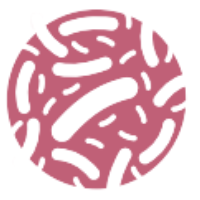
Postbiotics bring a new inspiration for modulating gut health due to their advantages.
Postbiotics and the advantages of their use in animal production
Throughout the years several different terms have been created and used for postbiotics. For example:
The term “postbiotics” was first coined by Tsilingiri et al. , and suggests that they are metabolic products derived from probiotics, which exert beneficial effects on the host directly or indirectly (Tsilingiri et al., 2012).
![]() In 2019, the International Scientific Association of Probiotics and Prebiotics (ISAPP) proposed a definition for “postbiotics” as the “preparation of inanimate microorganisms and/or their components that confer a benefit to the host’s health” (Swanson et al. , 2020). [register]
In 2019, the International Scientific Association of Probiotics and Prebiotics (ISAPP) proposed a definition for “postbiotics” as the “preparation of inanimate microorganisms and/or their components that confer a benefit to the host’s health” (Swanson et al. , 2020). [register]
 The safety of probiotics is associated with their subsequent use. Although few studies have reported on this topic, there were potential risks associated with probiotics, including:
The safety of probiotics is associated with their subsequent use. Although few studies have reported on this topic, there were potential risks associated with probiotics, including:
Postbiotics are inanimate microorganisms and their products which lose the ability to replicate and produce. Therefore, they are free of the risks mentioned above.
The rate of live microorganisms in probiotics is uncertain at the end of their shelf life due to the death of live microorganisms within different storage conditions. Therefore, probiotics tend to be included in excess doses to prevent the loss of live microorganisms during production.

Postbiotics can maintain stability during industrial processes and during long storage periods due to a lengthier shelf life. As a result, they have greater application possibilities than probiotics (Wegh et al. , 2019).
|
Postbiotic components
Various components and molecules derived from microorganisms still exist in postbiotics after processing, contributing to host health in different ways (Fig. 1).
Figure 1. Postbiotic components
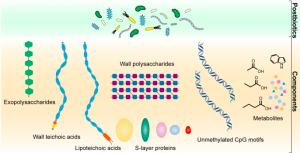 Modified from Zhong et al., 2022
Modified from Zhong et al., 2022
Exopolysaccharides
Exopolysaccharides (EPS) are extracellular carbohydrate polymers with high molecular weight compounds produced and secreted by microorganisms. They have gained greater attention during the last decades due to their therapeutic potential for medical applications and potential use within the food industry (Ghrairi et al., 2019).
EPS can be found in abundance in lactic acid (LAB) bacteria, including Lactobacillus, Lactococcus, Bifidobacterium, Leuconostoc, Pediococcus, Streptococcus, and Weissella (Nguyen et al., 2020).
Beneficial effects of EPS on gut health have been observed, including activities such as:
![]() In addition, EPS could prevent bacterial adhesion to the epithelium and contribute to preserve the integrity of the gut’s epithelial barrier (Oerlemans et al., 2021).
In addition, EPS could prevent bacterial adhesion to the epithelium and contribute to preserve the integrity of the gut’s epithelial barrier (Oerlemans et al., 2021).
Cell wall fragments
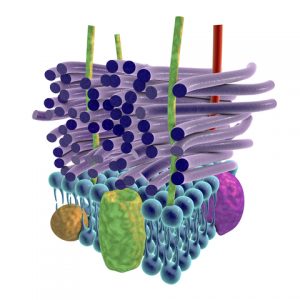
Most probiotics to date, including Lactobacillus and Bifidobacterium, are gram-positive. The cell wall of gram-positive bacteria is a complex set of:
All of these are considered beneficial components for the host.
![]() Previous studies have revealed that probiotic-derived peptidoglycans or commensal LABs could play a positive role in maintaining the gut’s immune balance.
Previous studies have revealed that probiotic-derived peptidoglycans or commensal LABs could play a positive role in maintaining the gut’s immune balance.
Teichoic acids are anionic polymers formed by repetitive alditol-phosphate units and can be classified into wall teichoic acids (WTA) and lipoteichoic acids (LTA).
The importance of teichoic acids in host cell adhesion, inflammation, and immune activation has been highlighted (Swoboda et al., 2010).
 LTA could induce TNF-α secretion from macrophages.
LTA could induce TNF-α secretion from macrophages.

S-layer proteins (SLP) represent one of the most abundant cellular proteins and interact with the host and its immune system. SLP from probiotics can contribute to the adhesion to epithelial cell and extracellular matrix proteins, thereby inhibiting pathogen infections and further benefiting the host (do Carmo et al. , 2018).
Synthetic oligodeoxynucleotides(ODN) containing CpG motifs were found to be an effective immunotherapy for several diseases, including the treatment of malignant tumors (Klinman, 2004).
Metabolites
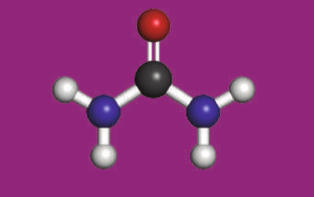
Probiotics may interact with the host through metabolites such as:
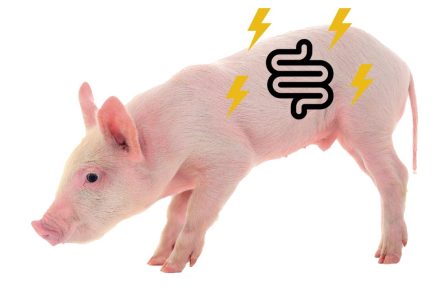
Benefits of postbiotics on intestinal health: Protective effects against pathogens
Alterations of the intestinal microbiota, such as pathogen colonization, cause intestinal health damages and diseases.
Postbiotics can be used as a therapeutic approach to inhibit pathogens. Primarily through the use of their different components and establishing competition for the adhesion to the gut mucosa and epithelium.
Figura 2. Benefits of postbiotics on intestinal health
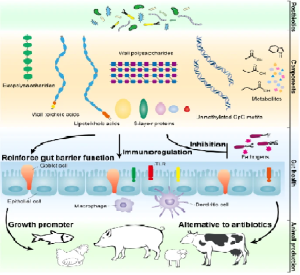
Source Zhong et al., 2022
Metabolites such as lactic acids, bacteriocins and SCFAs in postbiotics were observed to have a protective role against pathogen invasion through their diffusion across the bacterial membrane and by reducing the gut’s pH value (Lamas et al. , 2019).
![]()
In addition to direct antimicrobial activity, postbiotics could modulate the gut microbiota and inhibit pathogens, possibly through quorum sensing and adhesion.
Quorum sensing is a cell-cell communication process that allows bacteria to detect population density and regulate their behavior collectively (Fuqua et al., 1994).
Conclusions
| The use of postbiotics has shown great potential and may be an alternative to antibiotics in animal production. |
However, despite the fact that the inanimate state of postbiotics makes them more stable and safe than probiotics, their exact composition still remains somewhat of a mystery that needs to be unraveled in the near future. This will convert them into tools with proven efficacy, convincing those involved to adopt them as AGP alternatives. In addition, it is important to highlight the presence of complex interactions between various compounds and the host.
[/register]
Subscribe now to the technical magazine of animal nutrition
AUTHORS

Nutritional Interventions to Improve Fertility in Male Broiler Breeders
Edgar Oviedo
The Use of Organic Acids in Poultry: A Natural Path to Health and Productivity
M. Naeem
Synergistic Benefits of Prebiotics and Probiotics in Poultry, Swine, and Cattle
Gustavo Adolfo Quintana-Ospina
Hybrid Rye Potential in Laying Hen Feed Rations
Gwendolyn Jones
A day in the life of phosphorus in pigs: Part I
Rafael Duran Giménez-Rico
Use of enzymes in diets for ruminants
Braulio de la Calle Campos
Minerals and Hoof Health in the Pregnant Sow
Juan Gabriel Espino
Impact of Oxidized Fats on Swine Reproduction and Offspring
Maria Alejandra Perez Alvarado